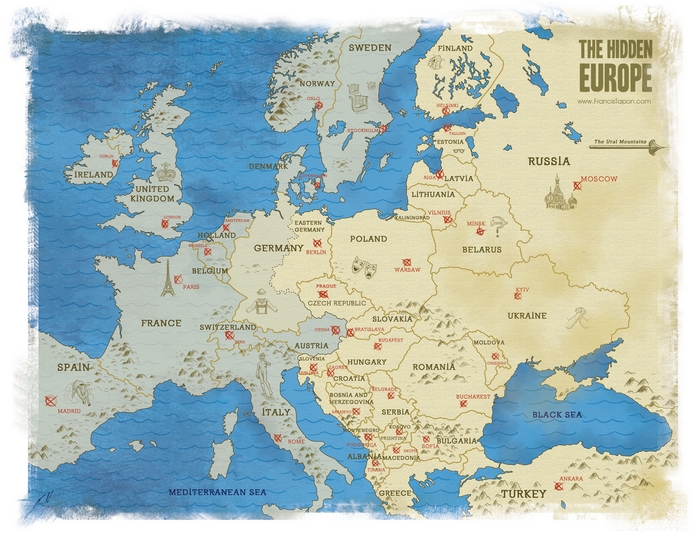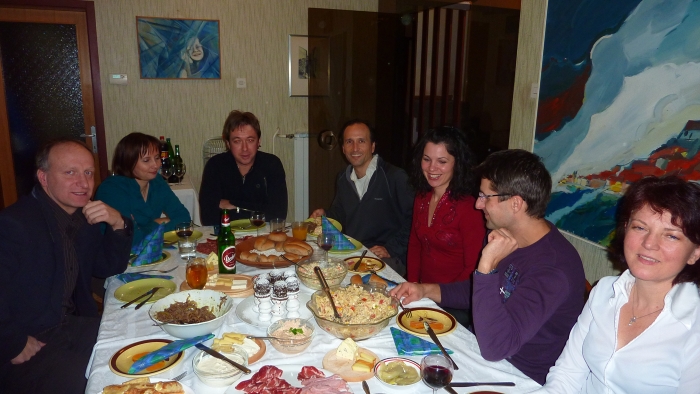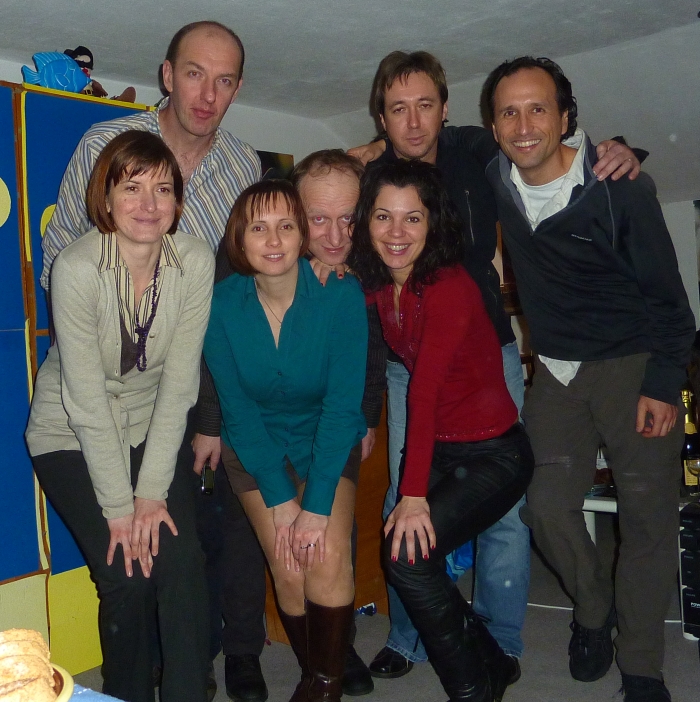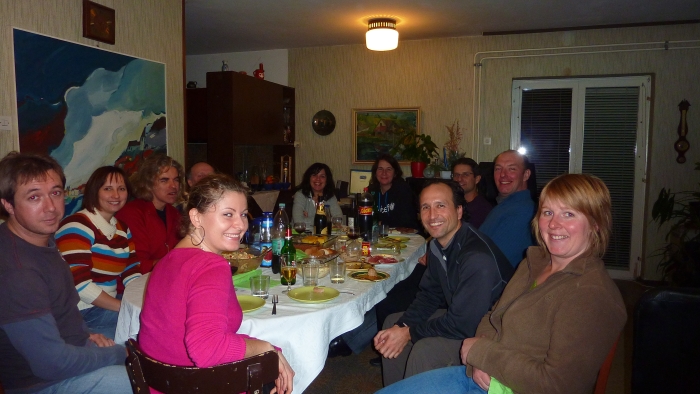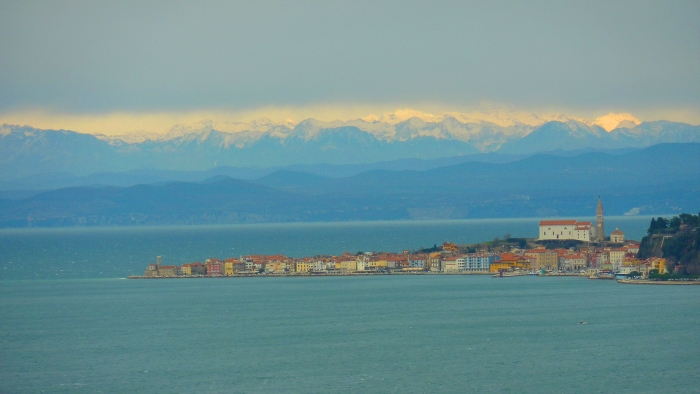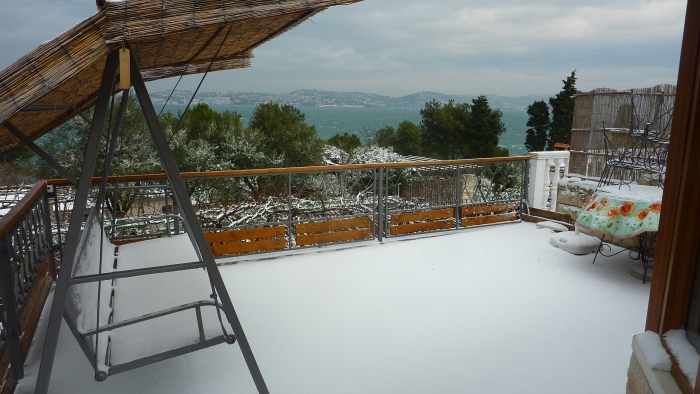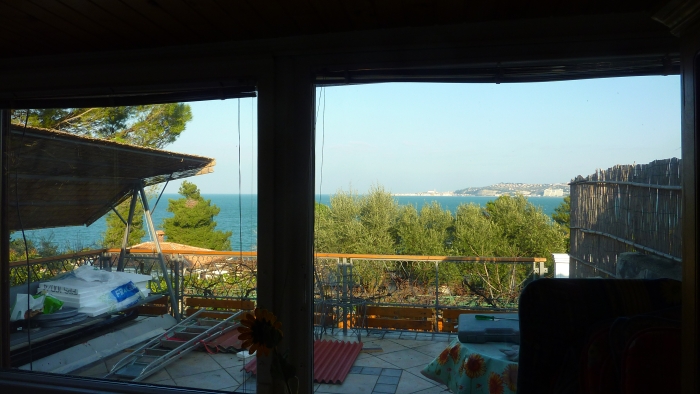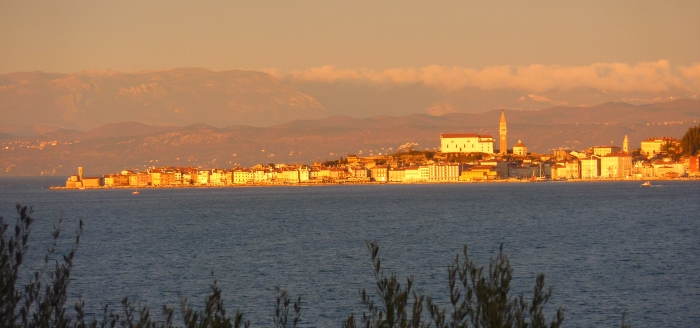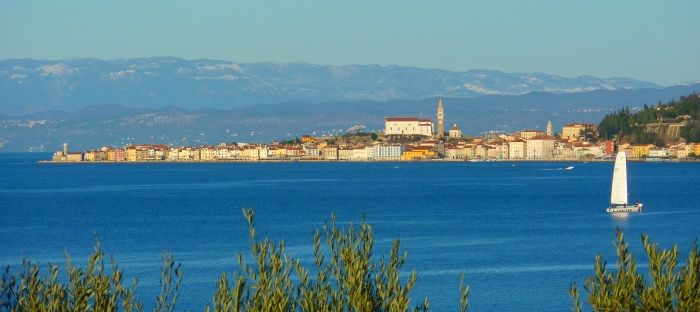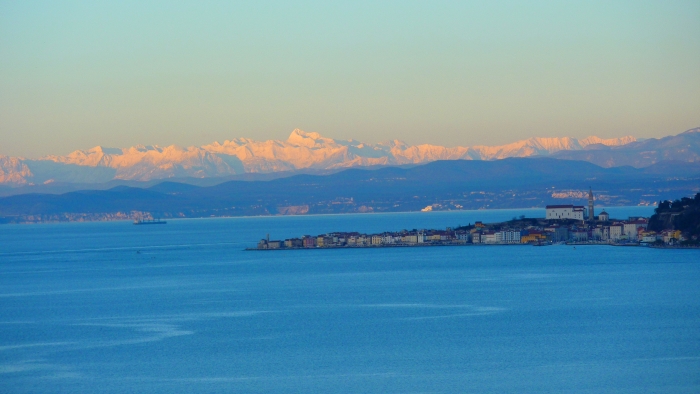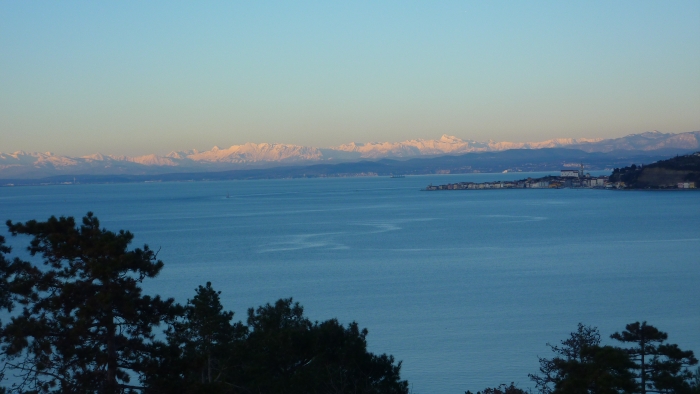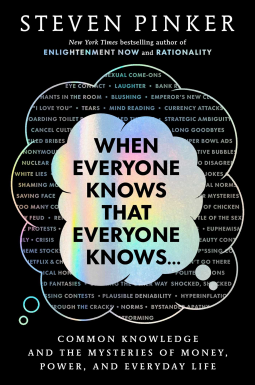Eastern Europe
Exploring the Hidden Europe in 2004 and 2008-2011
In 2004, I visited all 25 countries in Eastern Europe. You'll find the blog entries from that trip here. In 2008-2011, I returned to see what had changed since that time. With these two visits, five years apart, I accumulated enough material for my 750-page book, The Hidden Europe: What Eastern Europeans Can Teach Us.
This blog now has many excerpts from The Hidden Europe. But who the hell reads anymore? Just look at the best photos from Eastern Europe!
This map reflects how I define Eastern Europe. Eastern Europeans love to deny that they're in Eastern Europe. I tackle how and why I define Eastern Europe the way I do in the Introduction of The Hidden Europe.
The Most Controversial Statue in Eastern Europe: Estonia's Bronze Soldier
The 7-minute video below is a combination of photos and video of the statue, plus some music and my occasional narration. Although it won't win an Oscar, it's cheaper than a movie ticket.
Estonia's Bronze Soldier: The Most Controversial Statue in Eastern Europe from Francis Tapon on Vimeo.
After World War II, the USSR placed a bronze statue of a common soldier in the center of Tallinn, the capital of Estonia, a small country next to Russia. For Russians, the Bronze Soldier represented the triumph over the Nazis. Russians wanted to remind the Estonians that the Soviets had liberated the Estonians from the Nazis.
On the other hand, Estonians felt the Bronze Soldier symbolized the Russian domination and occupation. Every Victory Day (the anniversary of WWII), Russians would wave the Russian (or Soviet) flag around the Bronze Soldier.
By 2006, patriotic Estonians had enough. They wanted the Bronze Soldier removed. Ethnic Russians who live in Estonia disagreed.
In April 2007, protests reached a crescendo when two days of riots erupted in the streets of Tallinn. When the dust settled, one had died, millions of dollars of property damaged had been caused, and the statue was moved to the Military Cemetery in the outskirts of Tallinn.
Officials from the Russian government demanded that the Estonian government resign. Fear of war mounted. Ultimately, it didn't happen. At least, not yet.
Video tour of Tallinn, Estonia
I made this 8-minute video at the end of 2008
Tour of Tallinn's Old Town in Estonia during the snowy winter from Francis Tapon on Vimeo.
 In 2009, I went to a costume party for New Year's Eve in Parnu, Estonia. Everyone was supposed to be either a movie star or an animated character. I dressed up as a thru-hiker, using my sexy Jacks 'R Better convertible sleeping bag and its stylish green hood. The sleeping bag does double duty as a serape, but what its designers don't know is that it has a third use: a make-shift costume for a party. When asked what I was, I replied, "A green M&M."
In 2009, I went to a costume party for New Year's Eve in Parnu, Estonia. Everyone was supposed to be either a movie star or an animated character. I dressed up as a thru-hiker, using my sexy Jacks 'R Better convertible sleeping bag and its stylish green hood. The sleeping bag does double duty as a serape, but what its designers don't know is that it has a third use: a make-shift costume for a party. When asked what I was, I replied, "A green M&M."
Recommended reading
Read up about Estonia in Wikipedia and the CIA Factbook.
Travel deals to Estonia
Check my favorite travel sites:
Interactive map of Estonia

Slovenia's Julian Alps are the toughest, most dangerous trails I've ever hiked. I've been in other dangerous situations (challenging weather, high altitude, lost without food or gear for 3 days), but as far as a "trail" nothing is harder than the Julian Alps.
To make it harder, it would have to be rock climbing, which, in fact, is easier than this because here you don't have the safety equipment (a harness, rope, carabiners) unless you bring it. I did the adventure with the healthy, super athletic mountain-lover Ana Mismas.
See video, photos, and story below. I encourage you to watch the video in full-screen. Turn up the volume. If you're looking for hiking trip ideas, then get inspired by the video below!
2009 was a busy travel year for me. I visited nearly all the European countries. However, I calmed down in 2010. About six countries are on the list: Italy + ex-Yugoslavia. Below are some photos from a New Year's Eve party in Izola, Slovenia. Below that you'll see photo of Crveni Vrh, Croatia, the seaside location of where I wrote 80% of The Hidden Europe.
The 2010 New Year's Celebration in Izola, Slovenia
New Year's Eve in Izola, Slovenia. Four of these Slovenians had done a roadtrip together in the Western USA. When they told me the story I nodded with my mouth full.
This is one of Slovenia's largest dance floors.
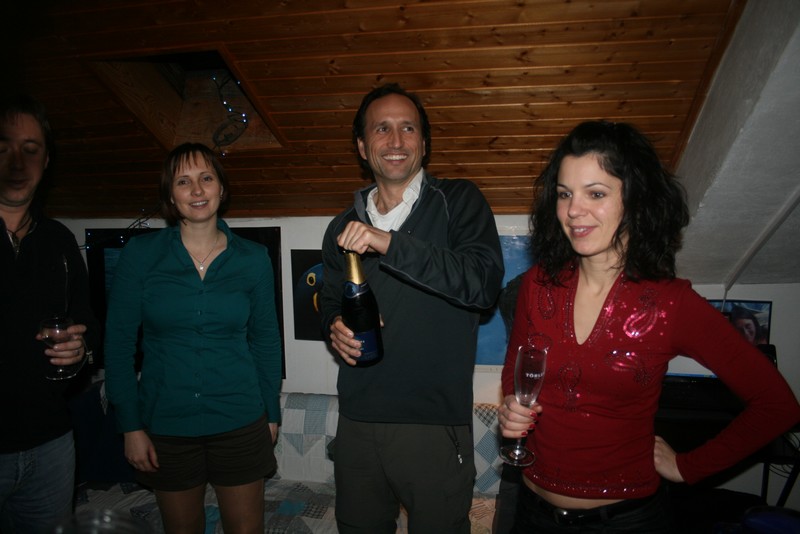
For some strange reason, the Slovenians gave the honors of popping the champagne at midnight to an American who doesn't drink alcohol.
New Year's Day 2010. My gracious and wonderful host, Tamara čelhar, is all the way in the back of this photo (just left of my head). She and many Slovenians tried to convince me that they drink a lot of alcohol, but I laughed and told them to go to Finland, Moldova, or Russia.
Izola is a 15-minute drive to the Croatian border. Then in another 15 minutes you will arrive at the perfect place to write a book....
Crveni Vhr, Croatia
I wrote most of The Hidden Europe in Crveni Vhr, Croatia. Below is the short story of how I got here and a few photos of the place.
In May 2008, I visited a Slovenian village at the base of the Julian Alps called Slap ob Idrijci. Slap in Slovenian means Waterfall, so the name of the village means Waterfall by the Idrijca River. There I met and stayed with Dušan Trušnovec's generous family. A few days later we went to his Croatian sea house, in a town called Crveni Vrh, whose hard-to-pronounce name means Red Summit.
While I was walking across Spain twice, Dušan, out of the blue, invited me to return and write my book at his house on the Adriatic Sea. It's every writer's dream: to write in a quiet seaside paradise. Indeed, as I type these words, out the window I see the Old Town of Piran, the Adriatic Sea, and the snowy Julian Alps.
This is the one snow fall this winter. Normally temps are 0-10 degrees Celsius. I've been here since mid-December 2009.
The view of the desk that I write on everyday. There's roof construction materials outside. On a clear day, you can see the Julian Alps.
.
Piran is in Slovenia, but I'm staying in Croatia. All my friends are in Slovenia, so I cross the EU border often. Piran looks golden at sunset.
The Old Town of Piran is 5km away, about 90 minutes swimming across Piran Bay. However, be careful, Slovenia and Croatia are having a big fight over who controls this Bay, so the overly zealous Slovenian Coast Guard might harpoon you if they think you're a Croatian swimmer trying to get to Piran.
The highest of those snowy peaks is Triglav, Slovenia's tallest mountain at 2,864 meters. I climbed it five years ago in sneakers and got yelled at for such brazenness.
This is the only photo that was NOT taken from the room that I write in. To see this view that I see everyday when I go for my run on Crveni Vhr (Red Summit or Red Hilltop). There's a dirt path on the crest that overlooks Piran Bay to the north and woods to the south. I loop back by dropping down to the sea level and running along a trail that hugs the water. It's a nice break between writing.

Photo credit: my New Zealand friends at CreativeShotz took this when they visited me.
There are no distractions. I have no car; only a bike. The nearest town is 10 km away. There is no Internet. The TV gets just a couple of Italian, Slovenian, and Croatian channels – I never turn it on. The village is a ghost town in the winter: 95% of the houses are empty. In short, there's nothing for me to do except write, write, write. As a writer, I've never been so productive in my life! It's amazing what a view and lots of peace and quiet can do for an author!
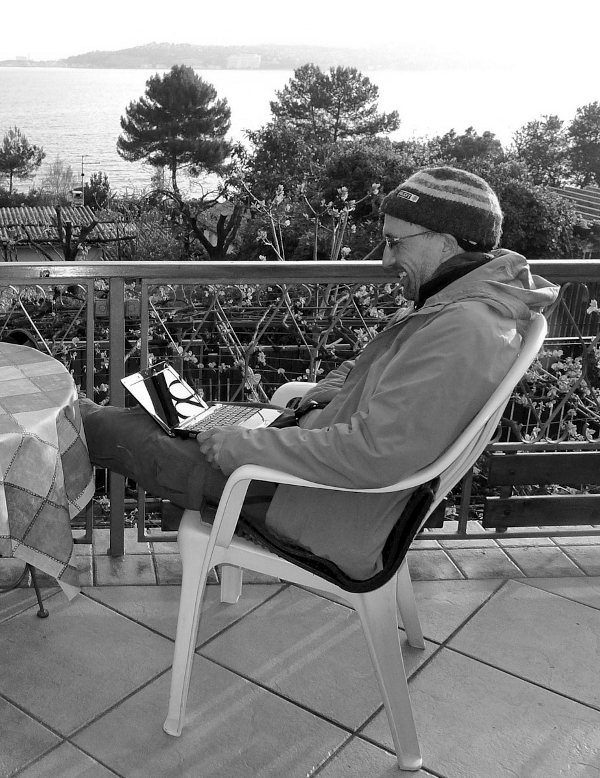
Photo credit: my New Zealand friends at CreativeShotz took this when they visited me.
My most productive writing period in my life was here in Croatia, overlooking Piran Bay and Slovenia.
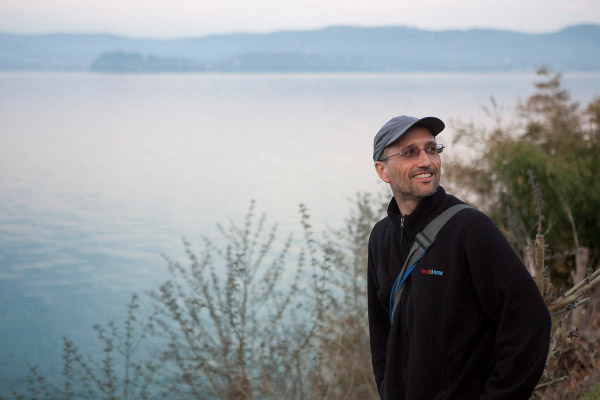
Photo credit: my New Zealand friends at CreativeShotz took this when they visited me.
I'm going for a stroll next to Piran Bay. I would run by here on my daily run.
- Western Russia
- Excitement in Estonia
- Anal Austrians
- Miseries in Minsk
- Bomb Damage in Bosnia-Hercegovina
- Braving Bulgaria
- Cavorting Croatia
- Cruising the Czech Republic
- Fun in Finland
- Hooking up with a Hawaiian in Hungary
- Camping in Kosovo
- Lost in Latvia
- Loving Lithuania
- Mixed up in Macedonia
- Marauding Moldova
- Moving to Montenegro
- A Promenade through Poland
- Roaming Romania
- Surviving Serbia
- Stupidities in Slovakia
Your comment will be deleted if:
- It doesn't add value. (So don't just say, "Nice post!")
- You use a fake name, like "Cheap Hotels."
- You embed a self-serving link in your comment.
